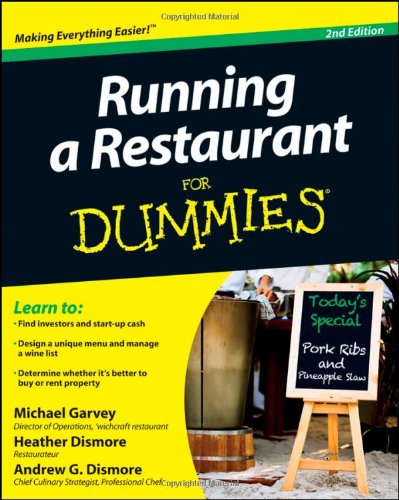Author: Michael Garvey, Heather Dismore and Andrew G. Dismore
Publisher: McGraw-Hill – 366 pages
Book Review by Nano Khilnani
From speaking to restaurant owners over the years, I have come across a broad range of opinions from “very satisfied” to “highly competitive and difficult,” when asked about their experience. There are many factors affecting their range of range of satisfaction on restaurant ownership from positive to negative, and from large profit to huge loss.
Some of those factors have to do with the personal backgrounds of the owners – their level of education, their prior experience in the restaurant field or lack thereof, their inclination such as like or dislike of this type of business, the amount of capital they invested and their return-on-investment (ROI) expectations.
Other factors are external in nature, such as net worth and income range of households in the location of the restaurant, the number of competitors owning the same type restaurant in a given location, and the economy in general: whether it is expanding or shrinking. All these factors govern potential customers’ attitudes toward spending on outside dining.
Still other factors have to do with the restaurant itself: its value proposition to customers in terms of the quality of its food and its looks or ambience, its prices relative to competing restaurants and the level of customer service, or QPS for short (quality, price, service).
This book focuses primarily on the third set of factors that makes a restaurant very profitable, a money-loser or somewhere in between. So if you think you think you have the right personal background, inclination and mind set to succeed in the restaurant business and feel confident that the state and direction of the economy is favorable to the restaurant business, this book is the tool you need to make your restaurant business a success.
The three authors of this book have ample experience among themselves to help you learn how to start and run a restaurant. Michael Garvey has had experience as a server, bartender and manager in different types of restaurants. Heather Dismore has managed restaurants of regional and national chains, developed their purchase, training and operations procedures and has authored several books. Andrew Dismore has experience as a chef and has helped develop food products for large, well-known restaurant chains.
This is a fairly large book of 366 pages that not only provides you a broad brush of the range of subjects one must know about the restaurant business, but also its details.
Organized into five parts with 21 chapters, in it you will learn the basics of restaurants, what types there are and how to decide which type you want to open, your market and competition in it. You will learn why you need to develop business plan and how to write it, where to get the capital, how to choose a location and obtain the needed legal papers.
It will show you how to develop the kitchen (the back of your shop) and the seating, furniture, furnishings and décor, perhaps a bar, and the waiting and reception area (the front of your shop). You also discover how develop a menu, and how-where to shop for the food, liquor, beverages and daily supplies.
The book helps you recruit, train and manage employees, manage your cash, and promote your restaurant to bring in more customers and cash.
Part 1 has to do with getting started. Much of this has to do with learning – a critical part of gathering knowledge – rather than doing. You learn the basics of the restaurant business, the large range of types of restaurants out there and deciding which one you want, research the market and develop a business plan that will determine your revenues, expenses and net income.
Part 2 is doing the actions to make your restaurant dream a reality, such as getting the financing mainly, but also find the right location and getting all the permits and licenses.
Part 3 focuses on the your physical place of business and designing and buying all that you need to equip it and open your doors – your kitchen and the equipment and supplies you need; your dining (and bar if you want) and waiting-reception areas-the tables, chairs, and all else that will be part of it; an office area to develop and run your business.
Part 4 focuses on doing the necessary ongoing task to keep your restaurant running smoothly after you’ve set it up, such as building loyal clientele, making sure your employees are productive and happy, and keeping your place clean and safe, and maintaining what you’ve worked to create.
Part 5 has ten myths about running a restaurant and ten true restaurant stories for you to learn from to make you a better restaurant owner.
This is a great book for anyone planning to open or is already running a restaurant.







